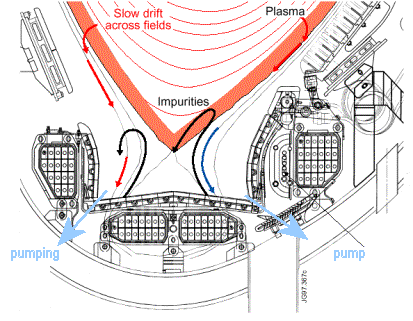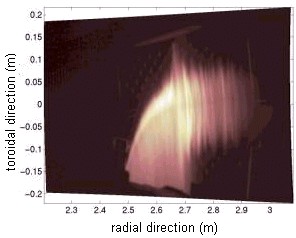|
5) Plasma-wall interaction and particles and heat extraction
(p 1 -
2
- 3 - 4
-
5 -
6 -
7 )
| How do we avoid helium particles, the ashes of the fusion reaction, building up in
the discharge and ending up by choking the plasma ? Just get on and pump them out. |
e) Extraction and injection of matter
The D-T fusion reactions produce "ashes", the
helium particles. These particles, created in the plasma core, give part of their energy to the plasma through collisions and thus serve to maintain the plasma, before
diffusing with the other particles towards the
plasma edge. To avoid their concentration to build up, thus eventually chocking
the plasma, special devices are implemented on the plasma facing components to extract them. This consists in collecting the ion
flux in neutralisation throat designed to guide the neutral flux thus created, insensitive to the effect of the magnetic field, towards a pumping system situated away from the machine.
|
We see here 2 pumping methods experimented on the Tore Supra limiters. The first method consists in directly collecting the ion
flux from the limiter throat and guiding it to a pumping system. The advantage: considerable efficiency in pumping, and the drawback: a
large flux on the throat leading. A second method consists in letting the incidental
ion flux neutralise on the limiter surface, and relying on atomic physics
processes to bring back some of the neutrals thus created to the slots leading to the pumping system. The advantage is no more contact
leading edge problem, and the drawback is reduced pumping efficiency.
|
| Here we see a cross section of the bottom of the JET tokamak, where the system
ensuring the particle extraction is shown. The plasma flux arrives at the edge zone, where it neutralises on the
divertor plates. The neutral flux is then collected through chevrons and guided to a pump.
|
 |
Most present machines work with pure deuterium (JET is the only machine in operation with the necessary installations to work with tritium to date) and extrapolate the results obtained with D-D to D-T fusion. We study helium pumping by
injecting helium into the plasma from the outside and by observing how the pumping system behaves. The performances attained are compatible with the requirements of a future reactor
(helium concentration in the plasma centre less than 10%).
It is unfortunately difficult to preferentially evacuate the helium at the
plasma edge. We thus extract everything that comes from it, a mixture of fuel (deuterium and tritium), ash (helium) and a low proportion of impurities emitted by the machine walls. This mixture is then sorted
out, the helium and impurities are eliminated, and we continuously re-inject fuel to compensate for what has been extracted from the
discharge. The pumping system is therefore destined not only to extract ash in the future reactor, but also to control the plasma fuel density in
present machines, by acting on the extracted and injected quantities.
Nevertheless, in addition to these so-called "active" pumping systems there is a so-called "passive" pumping
 , due to the wall. Indeed, carbon, a material very often chosen for plasma facing components on account of its strong resistance to thermal shock and its low atomic number reducing of
radiation problems, has a very specific property: it is a real hydrogen sponge, capable of absorbing a large part of the
flux of incidental particles, until the material becomes saturated. It may then spit out particles that it has absorbed, particularly in the case of overheating. The wall is thus to be reckoned with, when we try
to control the plasma density.
, due to the wall. Indeed, carbon, a material very often chosen for plasma facing components on account of its strong resistance to thermal shock and its low atomic number reducing of
radiation problems, has a very specific property: it is a real hydrogen sponge, capable of absorbing a large part of the
flux of incidental particles, until the material becomes saturated. It may then spit out particles that it has absorbed, particularly in the case of overheating. The wall is thus to be reckoned with, when we try
to control the plasma density.
As for plasma supply, we have three means of fuel injection
 into the plasma :
into the plasma :
-
injection of gas from a pipe arriving in the vacuum chamber. Easy to set up, this method is not very efficient but very commonly used on tokamaks (typically 20% of
the injected particles penetrate into the plasma on Tore Supra)
-
neutral
injection, which also serves as heating system. The efficiency is greater, but the quantities injected are small and are not always enough to supply the
plasma.
-
ice pellets
injection, which consists of injecting tiny deuterium or tritium pellets in the form of ice. We use systems that look like compressed air pistols, capable of injecting deuterium pellets at several kilometres per second. The device is complex, but results in much better plasma filling performance than gas injection (reaching
efficiencies up to 80% on Tore Supra). Developments are in progress to adapt current pulsed systems towards continuous operation.
|
The image opposite represents injection of a pellet into Tore Supra seen from above, detected by a camera sensitive to the radiation of neutral deuterium. The halo corresponds to a very dense cloud of neutral particles surrounding the pellet, which "melts" in the course of its
path within the plasma, spreading its contents, which ionise (and then become invisible to the camera) on the magnetic surfaces that it crosses.
|

|
|
|